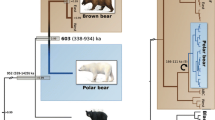Abstract
Realist philosophies of science posit a dialectical relation between theoretical, explanatory knowledge and practical, including taxonomic knowledge. This paper examines the dialectic between the theory of descent and empirical, Linnaean taxonomy which is based on a logic of traditional classes. It considers the arguments of David Hull to the effect that many of the practical problems of empirical classification can be resolved by means of an ontology based upon the theory of descent in which species taxa are regarded as individuals rather than as classes or natural kinds.Contra Hull, it is argued that this view is, at best, only partially consistent with taxonomic practice and that it cannot sustain experimental practice which presupposes that species taxa be regarded as natural kinds. An outline is given of a possible alternative dialectic between a field theory of morphogenesis and a rational systematics involving a logic of relations.
Similar content being viewed by others
References
Bateson, W. (1886), The ancestry of the chordata. Quart. J. Micros. Sci. 26: 535–571.
Bateson, W. (1894). Materials for the Study of Variation. London, MacMillan. Reprinted 1992. Baltimore, Johns Hopkins University Press.
Bateson, W. (1913). Problems of Genetics. New Haven, Yale University Press.
Belousov, L. and A. Lakirev (1992). Why five? Biol. For. 85: 93–102.
Bhaskar, R. (1978). A Realist Theory of Science. Brighton, Harvester.
Buck, R.C. and D.L. Hull (1966). The logical structure of the Linnaean hierarchy. Systematic Zool. 15: 97–111.
Cassirer, E. (1923). Substance and Function. Reprinted 1953, New York, Dover Publications Inc.
Darwin, C. (1859). On the Origin of Species by Means of Natural Selection. Reprinted 1968. Harmondsworth, Penguin Books.
Driesch, H. (1908). The Science and Philosophy of the Organism. London, Black.
Goldschmidt, R.B. (1958). Theoretical Genetics. Berkeley, University of California Press.
Goodwin, B.C. (1984). A relational or field theory of reproduction and its evolutionary consequences. In: M.W. Ho & P. Saunders eds., Beyond Neo-Darwinism. London, Academic Press.
Goodwin, B.C. (1990). Structuralism in biology. Science Progress. 74: 227–244.
Goodwin, B.C. and L.E.H. Trainor (1980). The ontogeny and phylogeny of the pentadactyl limb. In: B.C. Goodwin, N.J. Holder & C.C. Wylie eds., Development and Evolution, Cambridge, Cambridge University Press.
Harré, R. (1986). Varieties of Realism. Oxford, Basil Blackwell.
Harré, R. and E.H. Madden (1972). Causal Powers. Oxford, Basil Blackwell.
Harrison, B. (1979). An Introduction to the Philosophy of Language. London, Macmillan.
Hull, D.L. (1969). Essay review: What philosophy of biology is Not. J. Hist. Biol. 2: 241–268.
Hull, D.L. (1975). Central subjects and historical narratives. History and Theory. 14: 253–274.
Hull, D.L. (1976). Are species really individuals? Systematic Zool. 25: 174–191.
Hull. D.L. (1978). A matter of individuality. Philos. Sci. 45: 335–360.
Hull, D.L. (1981). Discussion: Kitts and Kitts and Caplan on species. Philos. Sci. 48: 141–152.
Hull, D.L. (1984). Historical entities and historical narratives. In: C. Hookway, ed., Minds, Machines and Evolution. Cambridge, Cambridge University Press.
Huxley, J.S. and G.R. de Beer. The Elements of Experimental Embryology. Cambridge, Cambridge University Press.
Kripke, S.A. (1980). Naming and Necessity. Oxford, Blackwell.
Lévi-Strauss, C. (1968). History and anthropology. In: Structural Anthropology I London, Allen Lane the Penguin Press.
Putnam, H. (1975). Is semantics possible? & The meaning of meaning. In: Language and Reality: Philosophical Papers. vol 2. Cambridge, Cambridge University Press.
Webster, G. (1992). William Bateson and the science of form. In: W. Bateson, Materials for the Study of Variation. Reprinted 1992. Baltimore, John Hopkins University Press.
Webster, G. (1993). Driesch, Cassirer and the Logical Form of Rational Systematics (in preparation).
Webster, G. and B.C. Goodwin (1982). The origin of species: A structuralist approach. J. Sociol. Biol. Struct. 5: 15–47.
Webster, G. and B.C. Goodwin (1988). Il Problema della Forma in Biologia. Rome, Armando Editore.
Author information
Authors and Affiliations
Rights and permissions
About this article
Cite this article
Webster, G. Causes, kinds and forms. Acta Biotheor 41, 275–287 (1993). https://doi.org/10.1007/BF00709366
Issue Date:
DOI: https://doi.org/10.1007/BF00709366




